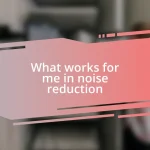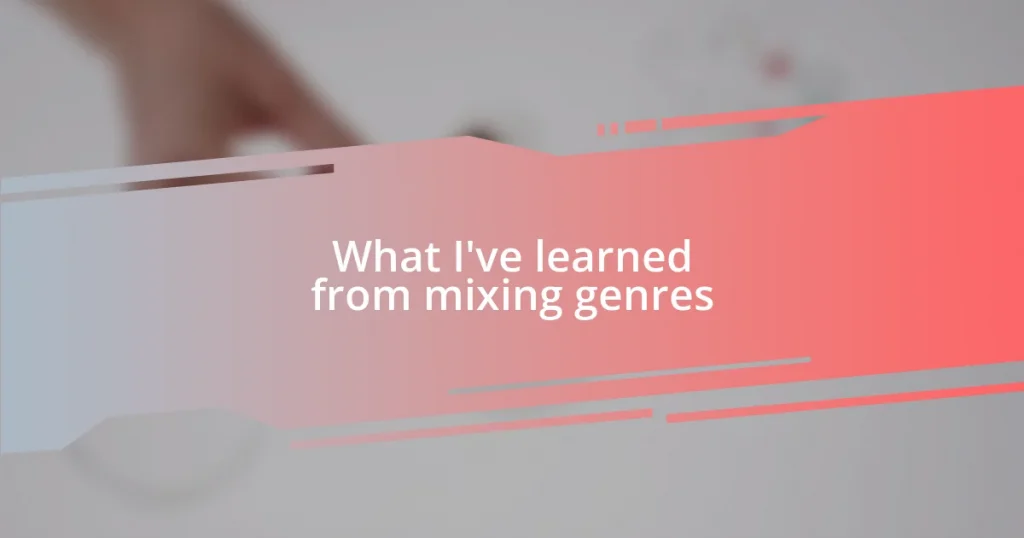Key takeaways:
- Mixing genres can unlock unique emotional connections and broaden artistic expression, as seen in personal experiences of blending styles like jazz and hip-hop.
- Genre blending can attract diverse audiences, foster creativity, and evoke complex emotions, while presenting both artistic and technical challenges.
- Successful collaborations, such as Kendrick Lamar with BadBadNotGood and Kacey Musgraves’ pop-infused country, highlight the power of merging genres to enhance storytelling and connect with listeners.

Understanding genre blending
Understanding genre blending truly transforms the creative process. I remember the first time I experimented with mixing jazz and hip-hop in my music production. The unexpected combination of smooth melodies with rhythmic beats unlocked a whole new world of expression that felt exhilarating.
It’s fascinating how genre blending can resonate on so many levels. Think about it: when you hear a song that incorporates elements from both rock and classical, don’t you feel a rush of emotions as those contrasting styles collide? For me, that sensation is a reminder of how powerful art can be when it dares to break the rules.
One of the biggest revelations I’ve had is that blending genres isn’t just about combining sounds; it’s about evoking deeper connections and emotions. I’ve found that creating something unique often reflects my own experiences—like fusing elements from pop and folk to express longing and joy simultaneously. Isn’t it amazing how our individual stories can shape the music we make and the genres we explore?

Benefits of mixing genres
Mixing genres offers a unique opportunity to reach broader audiences. Early in my career, I released a project that fused reggae with electronic dance music. The response was overwhelming, with listeners from both genres engaging with my work. It felt rewarding to see people connect and share their love for music in ways I hadn’t imagined.
Beyond audience appeal, genre blending can spark creativity and innovation. I remember experimenting by incorporating country elements into a hip-hop track. This challenge pushed me out of my comfort zone, leading to fresh ideas and sounds that I hadn’t encountered before. That moment of realization—that creative boundaries can be stretched—is what keeps me passionate about music.
There’s also a profound emotional impact to mixing genres. When I merged blues with pop, I discovered a way to express vulnerability through upbeat tunes. The juxtaposition of sorrowful lyrics against lively melodies created a depth in my music that resonated deeply with listeners. It reminded me that combining genres can reflect the complexities of our emotions and experiences, making the artistic process all the more fulfilling.
| Benefit | Description |
|---|---|
| Broader Audience Reach | Mixing genres attracts diverse listeners, creating a larger fan base. |
| Spark Creativity | Challenges artists to explore new sounds and ideas, enhancing originality. |
| Emotional Depth | Combining contrasting elements can evoke complex emotions in listeners. |

Common genre combinations
Common genre combinations stand out for their ability to create unexpected synergies. For instance, I’ve dabbled in blending electronic music with acoustic folk. The contrast between synthesized sounds and organic instruments produced an intimate yet vibrant experience. Every time I shared these tracks with friends, their smiles—and sometimes surprised reactions—reminded me that genre combinations can evoke genuine joy and connection.
Here are some popular pairs that I’ve come across and found intriguing:
- Hip-Hop and Jazz: The smooth flow of jazz can enhance the rhythm and storytelling in hip-hop, offering a rich auditory landscape.
- Country and Rock: This combination often results in an energetic, anthem-like quality that appeals to a wide audience.
- Metal and Orchestra: The powerful blend creates epic compositions, showcasing emotional depth while maintaining a heavy edge.
- Reggae and Pop: I’ve noticed that this fusion radiates positivity, making it perfect for summer playlists.
- Indie and Electronic: The airy sounds of indie music coupled with electronic beats can create atmospheric tracks that are both introspective and uplifting.
Each genre combination holds its own charm, revealing new dimensions of creativity that I find endlessly fascinating.

Techniques for effective mixing
When it comes to effective mixing, one technique I often rely on is layering instruments. I’ve found that, by intertwining different sounds, like adding a subtle piano line beneath a driving bass beat, I can create lush sonic landscapes. Have you ever felt how a single note can transform an entire song? It’s magical how these layers can add depth and texture, making music feel more immersive.
Another approach I love is to experiment with tempo and rhythm. For example, I once slowed down a fast-paced track to create a more relaxed feel, which was met with delight during a live show. This shift didn’t just alter the song; it changed the whole atmosphere, encouraging listeners to vibe together in a new way. I often ask myself, how can a simple change in rhythm evoke such a strong emotional response? The answer lies in the connection formed through shared musical experiences.
Additionally, incorporating unconventional sounds can elevate a mix to new heights. Once, I used field recordings of city sounds in a dance track, creating an urban atmosphere that was both gritty and vibrant. Listeners would often approach me after the show, commenting on how those sounds made them feel present in a moment. Isn’t it fascinating how blending natural soundscapes with traditional instruments can resonate on such a profound level? It’s these unique elements that keep the art of mixing exciting and dynamic.

Case studies of successful merging
I’ve always been drawn to the creative space where genres collide, and a standout example is the collaboration between Kendrick Lamar and the jazz collective, BadBadNotGood. Their track “Mortal Man” showcases how jazz improvisation can lend an emotional depth to rap. Each time I listen, I’m struck by how the freeform jazz contrasts with Kendrick’s powerful lyrics, creating a rich narrative tapestry that lingers long after the song ends. Can you feel how this blend not only enhances storytelling but deepens emotional connection as well?
Another notable case is the success of country artist Kacey Musgraves, who infuses pop elements into her music. Her hit “Butterflies” combines traditional country storytelling with polished pop production, creating an anthem about love that resonates across demographics. Listening to this song, I can’t help but smile at how the uplifting melody paired with genuine lyrics captures the joy of newfound romance. Isn’t it remarkable how merging genres can bridge differences and bring audiences together?
I’ve also been amazed by the combination of metal and orchestral music found in the work of bands like Nightwish. Their epic compositions infuse symphonic elements into heavy metal, culminating in a sound that feels both vast and personal. When I first heard their track “Storytime,” the way the orchestration elevated the intensity of the guitar riffs was transformative. It left me pondering: how can such complex arrangements evoke grand emotions while still feeling intimate? This fusion illustrates that merging genres isn’t just a technical endeavor; it’s a journey into a realm of shared human experience.

Challenges in genre mixing
Mixing genres can often feel like walking a tightrope. There’s a fine balance between maintaining the essence of each genre while crafting something fresh and cohesive. I remember trying to blend folk with electronic elements for a project; while the experiment had its bright moments, I soon realized that the contrasting energies sometimes clashed more than they harmonized. Have you ever experienced that moment between creative freedom and losing your footing?
Another challenge lies in audience expectations. As a creator, I’ve felt the weight of wanting to please fans who swear by just one genre. When I released a track that fused reggae with rock, some fans embraced it, while others seemed uncertain, unsure of where my music was headed. It made me ask myself, how do you remain true to your artistic vision while honoring the loyal listeners who might not be ready for departure from their favorite sound?
Additionally, I often grapple with the technical aspects of genre blending. Not every studio setup is equipped to handle the unique demands of different styles. For instance, trying to capture the raw authenticity of acoustic guitar alongside heavy synths can be daunting. I recall spending an entire weekend adjusting levels to find that sweet spot—a testament to the meticulous nature of mixing. Isn’t it intriguing how the technical side can sometimes challenge the creative flow and lead us to discover entirely new possibilities?

Tips for aspiring genre mixers
Experimentation is key when mixing genres. I remember when I first tried to blend jazz and hip-hop; it felt freeing to play around with rhythm and melody. But I soon realized that finding the right balance required patience and an open mind. Have you ever felt like you were searching for a needle in a haystack when trying to perfect a sound? Each attempt brought me closer, revealing nuances I hadn’t noticed before.
Don’t shy away from feedback, either. Early on, I would share rough mixes with friends who had diverse music tastes. Their reactions helped me see my work from different perspectives and pushed me to refine my ideas further. I began to appreciate how a simple critique, whether positive or constructive, could spark a creative breakthrough. Have you sought out opinions that challenged your view? Sometimes, it’s those unexpected insights that can illuminate the path forward.
Lastly, immerse yourself in both genres you’re mixing. I recall diving deep into the intricacies of blues and electronic music when working on a project that fused the two. This exploration not only enriched my understanding but also sparked inspiration in the most unlikely moments—like while washing dishes or taking a walk. Isn’t it fascinating how the right influences can seep into your daily life and transform your craft? Embrace this continuous learning journey; it’s where the magic truly happens.













